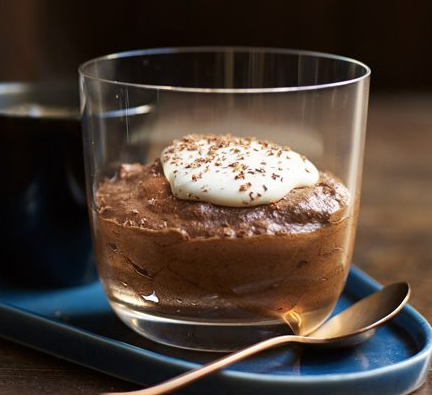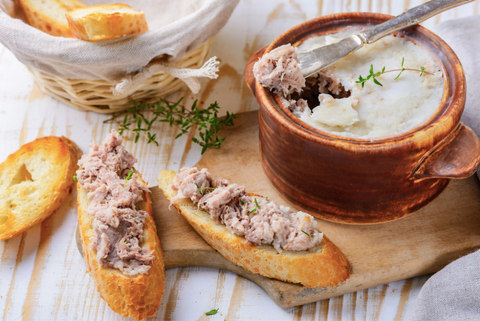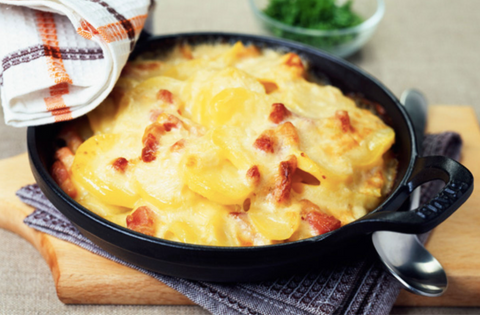What is the Dessert Mousse?
Mousse is a sweet or savory dish that incorporates air bubbles to give it a light and airy texture. Depending on preparation techniques, it can range from light and fluffy to creamy and thick. A mousse may be sweet or savory. Dessert mousses are typically made with whipped egg whites and Cream, flavored chocolate, coffee, caramel, puréed fruit, or nuts. Sweetened Mousse is served as a dessert or used as an airy cake filling. It is sometimes stabilized with gelatin. Savory Mousse may be flavored with herbs, fish, and other ingredients.
- Raw egg whites (unwhipped) give a very light texture to sweetened whipped Cream; the protein in the egg whites acts as a foaming agent (like soap bubbles) and gives to the fat in the Cream what is called an "emulsion" (like oil and vinegar for salad dressing); this "cream mousse" was invented by chef Auguste Escoffier.
Mousse au Chocolate
Mousse au Chocolat (chocolate mousse) is an example of a dessert mousse. Dairy-based mousses are usually made with whipped Cream (called crème.
- A dessert mousse is a light, airy concoction that whips air bubbles into a cream or custard. The most common type of Mousse is chocolate — it can be made with white chocolate, milk chocolate, or dark chocolate.
- However, other ingredients, from liquor to pureed fruit, are mixed in to create different flavors.
There are also savory mousses that use meat and fish as the main ingredient; these are typically served as appetizers. A foie gras mousse is one of the most popular examples.
Four basic components of a Mousse
- A foaming agent - in this case, egg whites
- A stabilizer - to keep the foam from collapsing (we use gelatin)
- A flavoring component - usually some liquid and fruit in this case, but it can be an ingredient you like.
- A sweetener is also usually some liquid and fruit, but it can be an ingredient that you like…
Mousse is a light and airy dessert made with eggs, sugar, heavy cream, and flavoring. All mousses have four basic components: aerated egg yolks, whipped egg whites, whipped cream, and a flavoring base.
All mousses follow the same basic steps for preparing them. The final flavor is determined by what the chef adds to the base.
The aerated egg yolk recipe is basic: sugar, water, and egg yolks are cooked together until thickened. Once cooled, this mixture is whisked until it becomes light in color and fluffy in texture. The egg yolk base provides a creamy foundation for the Mousse.
After whipping the egg whites, they are folded into the aerated egg yolks to provide somebody and structure to the Mousse. A foamy consistency results from folding too quickly; folding too slowly can deflate the beaten whites.
Whipped Cream is folded into the whipped egg whites as a stabilizer; as with the whipped whites, it can be over-mixed, which will result in a liquid consistency instead of a firm one. Finally, the two are combined by pouring small.
What is a Mousse?
Mousse is a dessert made with cream, eggs, and sugar that has been whipped with air to give it a light, foamy texture. Mousse can be savory or sweet, though most often; it's on the sweeter side. It's served cold and maybe topped with whipped cream or fruit.
Mousse can be made in five minutes if you use an electric mixer. To make Mousse the old-fashioned way, use a whisk and beat the ingredients over heat to create a custard base. Then hit the mixture until stiff peaks form. Mousse should have a creamy texture and not be too stuffy or too runny if it's made right. Ideally, it should hold its shape and not collapse when served.
There are two types of Mousse:
- Cooked Mousse (also called mousseline) and
- Uncooked Mousse (also called mouse au Chocolat). Mousseline starts with a custard base combined with whipped Cream once it thickens from cooking. Mousse au Chocolat starts with melted chocolate.
Why chocolate Mousse is called Moose?
Moose is a sweet, thick, and creamy dessert made by simmering milk or Cream with sugar and cocoa powder.
Moose is popular in the UK and is typically served in the summer. It can be topped with whipped cream, candied nuts, and chocolate shavings.
Chocolate mousse can be prepared using a variety of ingredients and recipes.

Chocolate Mousse is easy to prepare
Chocolate Mousse is a familiar dessert to many. Made with dark chocolate (or white or milk, if you prefer) and whipped cream, it is light and airy, with a rich flavor. It can be served alone or topped with fruit. It's usually a bit sweet but not too sweet; the dark chocolate balances it.
Chocolate Mousse is an easy dessert to make at home and takes less than 30 minutes to prepare. It's also very versatile — you can use any chocolate and whipped cream. According to onceuponachef you can even substitute other flavors for the chocolate, like vanilla or coffee.
Is Pudding and Mousse the same?
No, pudding and Mousse are very different. They may seem similar, but the slightest change in ingredients can change their flavor and texture.
- Pudding is sweet custard that's thicker than Mousse. Custard is a dessert or sauce made with eggs, sugar, and milk or Cream. Pudding can be thickened by starch or gelatin.
- Mousse is a French word for "foam." It's a light and airy mixture of Cream, eggs, and sugar whipped together until it turns into foam. There are two types of Mousse: sweet and savory.
- Sweet Mousse is usually made with chocolate or fruit and served as a dessert. Savory Mousse can be meat-based or fish-based and served as an appetizer.
Does Mousse have raw egg in it?
Depends on the recipe there are a few recipes for a mousse that use raw eggs and a few that don't.
The main recipe for Mousse is whipped Cream, egg whites, and sugar. The eggs are usually separated, and the whites are traditionally cooked over a double-boiler (tempered) before being whipped into the Cream.
Other recipes just beat the egg yolk with sugar and add it to the whipped cream at the end. So it would be safe to say that most mousse recipes call for using tempered eggs (the majority of recipes I could find did), but some don't.
Difference between Mousse and soufflé
- Both soufflé and Mousse are dessert dishes. The word 'soufflé' is derived from the French term 'souffler,' which means puff or blow up, while 'mousse' is French for foam. The main difference between Mousse and soufflé is in their preparation method.
- Soufflé is a dessert type with a base made of egg yolks and egg whites beaten separately. The base is then mixed with various ingredients that give the soufflé its unique flavor and texture. These ingredients can include fruits, chocolates, cheese, nuts, etc. Next, the base is baked in an oven after adding the additional elements to it. When baked, the soufflé rises and forms a fluffy dish with an airy yet dense consistency and a light taste.
- Soufflés can be sweet or savory in taste depending on the additional ingredients used in their preparation. Sweet souffles are usually served as desserts, while savory ones are the main dishes.
- On the other hand, Mousse is a type of dessert that has a base made with Cream or milk whisked with egg whites or gelatin. Then, additional ingredients such as fruits, chocolate, etc., are added.
What do you eat with chocolate mousse?
Chocolate Mousse can be eaten with a variety of things. I usually like to eat mine plain, but you could also eat it with:
- Cookies
- Wafers
- Sponge cake
- Whipped topping
- Fruit
How long does Chocolate Mousse last?
Chocolate Mousse can be kept for 1-2 days in a refrigerator. Therefore, you can make chocolate mousse one day ahead of time and store it in the fridge until you are ready to use it.
Cover the chocolate mousse with plastic wrap and press the wrap against the surface of the Mousse, so no air gets in. The plastic wrap should not touch the Mousse; it just needs to cover the top so no air can get in.
Before serving, you can keep it in the refrigerator for 1 or 2 days.
Is Mousse a cake?
A mousse is a velvety smooth and light dessert. It can be sweet or savory and is typically served cold, but sometimes at room temperature.
The word Mousse comes from the French word for foam or froth. Hence, Mousse often has a fluffy or foamy texture, like whipped cream or beaten egg whites. The first mousse recipes were created in the late 18th century in France.
Mousse can be made from chocolate, cream cheese, fruit purees, avocados, and more.
How long does Mousse take to set in the freezer?
1 to 2 hours.
I have used regular Mousse and instant Mousse to set in the freezer. It takes about 1 to 2 hours for the Mousse to set.
- I do not recommend using a deep freeze for this purpose because the Mousse will not set perfectly.
- The temperature of the freezer should be around -18 degree Celsius.
- It is better to place the Mousse in a fridge rather than a freezer.
What makes Mousse Foam?
Mousses are the lightest and airiest of desserts. They're made with whipped egg whites, whipped cream, or even just air whipped into a combination of chocolate, butter, fruit puree, or even vegetables. Then, as they chill in the fridge, they set up into a soft but firm treat that can be scooped like ice cream.
Mousses can also be savory dishes. For example, you can use the same technique to whip up a chunky chicken salad or a smooth fish mousse. These are often served cold, though hot savory mousses can also be found.
The basic elements are simple: liquid ingredients are dissolved in an emulsion with air beaten into it. This is just like mayonnaise or hollandaise sauce, which is made by slowly dropping oil into egg yolks while beating them vigorously. This breaks the fat into tiny droplets suspended in watery liquid, creating an emulsion (a mix of two normally unmixable drinks).
Egg yolks contain lecithin, which acts as an emulsifier and keeps the oil suspended in the watery liquid.
How to fix Light Mousse?
Making Mousse is a little bit like playing with a chemistry set. If you don't get the ratios right, you can end up with some runny and unappealing results. The problem is likely caused by too much liquid in the recipe or insufficient gelatin, but improper mixing techniques can also cause it. Fortunately, a few simple fixes can help you achieve the desired texture in no time at all.
Correct Ratios
According to curiouscuisiniere the first thing to check is your recipe. Mousse should be light but not runny. You should be able to scoop it out of the bowl with a spoon, but it shouldn't be so dry that it flakes off the sides of the spoon like cake crumbs. The secret is balance: Too much liquid and not enough gelatin can cause problems.
Tips for Choosing Ingredients
Choose full-fat dairy products for mousse recipes that call for them. You're looking for products that are at least 40 percent fat, such as heavy cream or sour cream. Skim milk will make your Mousse watery because it contains too little fat to hold the gelatin in suspension properly.
Choose gelatin sheets instead of powdered gelatin for mousse recipes. Gelatin sheets are firmer and deliver more consistent results.
There are two major reasons for light Mousse:
- Too much liquid
- Too little gelatin.
To correct for too much liquid, use less next time and add water to the existing batch. For fixing too little gelatin try using a stronger solution next time or adding more gelatin to the current collection.
If you decide to add water to the existing batch, you can heat it slightly and break up any clumps of gelatin before adding the water. Make sure you measure the amount of water you add.
So you must have to try this delicious French Chocolate Mousse by bettycrocker.




